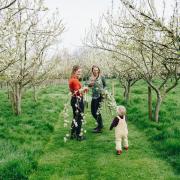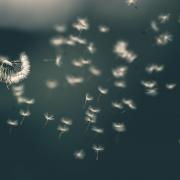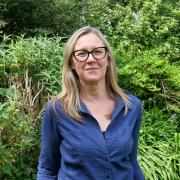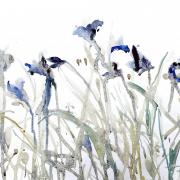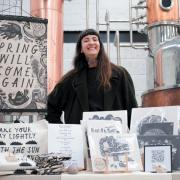Ever wondered what it would be like to live in a National Trust property? Tenant Kerry Bignell knows as she is lucky enough to live and work at Mottisfont in Romsey, former home of the quirky Maud Russell. Joanna Crosse meets her at the Abbey
As we flick through the latest property magazine, eyes drawn wistfully to images of imposing flag stoned entrance halls and gravel driveways flanked by towering beeches, we can be forgiven for indulging in that most pleasant of pastimes, and for a few moments, imagine life as the owner of an historic country house. Usually, the daydream ends when we consider the price tag attached, but for one Hampshire woman, the fantasy became a reality, and it didn’t cost her a penny. Kerry Bignell is the House Steward for National Trust property Mottisfont, a former Medieval priory set in one of the county’s most idyllic landscapes on the River Test. Seven years ago, looking for a change of direction after a career in television as a props manager, she successfully applied for the post of Conservation Assistant.Arriving for her interview, Kerry’s first impressions are ingrained on her memory: “In those days, you couldn’t see much from the car park, but when I crossed the bridge and suddenly caught sight of this beautiful house, the impact was tremendous. I knew I wanted to work here.”
Right at homeAt first, Kerry and her dogs, Ralph a French Bulldog, and Oscar a Highland Terrier, lived in one of the estate’s pretty cottages, but a promotion to House Steward meant they could move into the house she had already grown to love. “The views, particularly in spring, are heavenly. From my kitchen, I look out on to the Lime Avenue, carpeted with blue Chinodoxia flowers, while from the lounge I can enjoy Mottisfont’s huge plane trees, and a lawn littered with daffodils, which is sometimes visited by deer, foxes, even the odd heron.”As Kerry learned more about the history of the house, she became fascinated with the life of its previous owner, the vivacious and intriguing Maud Russell. Maud and her husband Gilbert purchased Mottisfont in 1934 as a country retreat in which to entertain their illustrious friends, including the Churchills, Ian Fleming (with whom she had a long-term affair) and members of the Bloomsbury Group. Maud soon embarked on a transformation of the house (already an eclectic mix of Medieval, Tudor and Georgian architecture), and introduced an elegant Neo-Classical style.
Inspired by the artsA wealthy patron of the arts, her parties brought together the social elite of the arts world. Through her connections with the ‘Bright Young Things’ set, she met the artist Rex Whistler: “She commissioned Rex to decorate the drawing room (now known as the Whistler Room), in a Gothic fantasy trompe l’oeil style, and his incredible murals are the centrepiece of her country house creation,” explains Kerry. Maud’s sense of ‘theatre’ is also evident in the Green Library, where a push on one of the book-lined walls reveals a doorway leading into what would originally have been a guest bathroom: “Maud definitely had a thing about secret panels; they were installed in her London home and North End House, which she moved to in 1972,” says Kerry.Maud’s creative spirit can also be glimpsed outside the house, nowhere more so than in the beautiful ‘Angel of Mottisfont’ mosaic. Created by one of her closest friends, Russian mosaicist Boris Anrep, and in the image of Maud herself, it is demurely tucked away on a corner of the Georgian south fa�ade, fringed by wisps of green foliage.“She really was an extraordinary woman. We’ve looked through her diaries, kept by the V & A, and her personality just leaps off the pages,” says Kerry. “One entry reveals that she kept a live crocodile in the nursery, while others refer to her work for the Admiralty during the war. She was of German Jewish descent and we know that she helped at least 11 families to flee Germany just before war broke out.”
Home from homeWith 800 years of history under its belt, some people may be wary of living in a place so steeped in the past. Kerry admits to the odd unexplained occurrence: “Sometimes, I get a strong whiff of alcohol when I open up the Morning Room, and other staff have noticed the aroma of cigar smoke in the kitchens, but whatever it is, it seems friendly enough, so I’m not worried!” In fact, it is the quiet periods that are the most special: “Of course, it’s fabulous to be able to show off the house and gardens, but it’s equally lovely to have them to myself for a while.” As the days lengthen, Kerry and the dogs enjoy evening strolls, often ending up at the famous walled rose garden: “One of my jobs is to ensure that the gates are shut, so I have the perfect excuse to wander up here. On a warm evening, you are met by the most delicious perfume, and that quintessential sound of summer: the humming of bees, many of which come from Mottisfont’s own hives.”Not surprisingly, Kerry’s home is popular with friends and family. “The lawns are perfect for picnics and the odd glass of wine on a summer’s evening. It’s at times like this that you can almost hear the faint sound of jazz wafting out from the windows of the Whistler Room, and envisage Maud’s colourful guests sipping cocktails on the terrace.”Maud loved the grounds, regularly taking afternoon tea on the lawn. She employed the services of top garden designers to create a natural landscape, but she loved colour too, and her gardener, Mr Buckle, grew elegant stemmed flowers such as irises, peonies and dahlias for year round displays in the house. Last year saw the creation of a new cut flower border, which will ensure Maud’s tradition continues.
First impressionsAs Kerry prepares for the new season, she reveals plans to re-introduce more of the glamorous post-war ‘look’ that epitomised Maud’s style. “The Russells gave Mottisfont great charm and cach�, and we’re hoping to re-create this look in several of the rooms, while retaining their family feel. Visitors often comment that this is a house they could imagine living in, which is lovely to hear. It isn’t overly grand, but it has a quiet beauty that blends in with the natural landscape around it.” Maud was keen that Mottisfont’s rural character as a working estate should be preserved, and with this in mind, she presented it to the National Trust in 1957, though she continued to take an interest in estate and village life until she died in 1982. “She was much respected by the local community, though her habit of walking in the middle of the road and making the traffic drive around her may not have endeared her to motorists!” laughs Kerry.“Everyone has an opinion on Mottisfont,” continues Kerry, “but my favourite ‘first impression’ is by the garden designer Norah Lindsay, who visited in 1935 and wrote in her diary: ‘Mottisfont is magnificent and romantic. It is all stone, with rushing rivers, vast old yew trees, cedars, and lawns and a charming atmosphere of the past. Inside are long corridors, late Georgian white panelled rooms, beautiful mantelpieces and great comfort.’ I think it is this wonderful air of ancient and romantic timelessness that continues to draw visitors back again and again. Mottisfont is definitely a place that is food for the soul.”
Pay a visitThe house opens for timed tours at 12pm and 2pm from March 1 to 21 and is then open from 11am to 5pm (excluding Fridays). For further information, visit www.nationaltrust.org.uk or call Mottisfont on 01794 340757.





